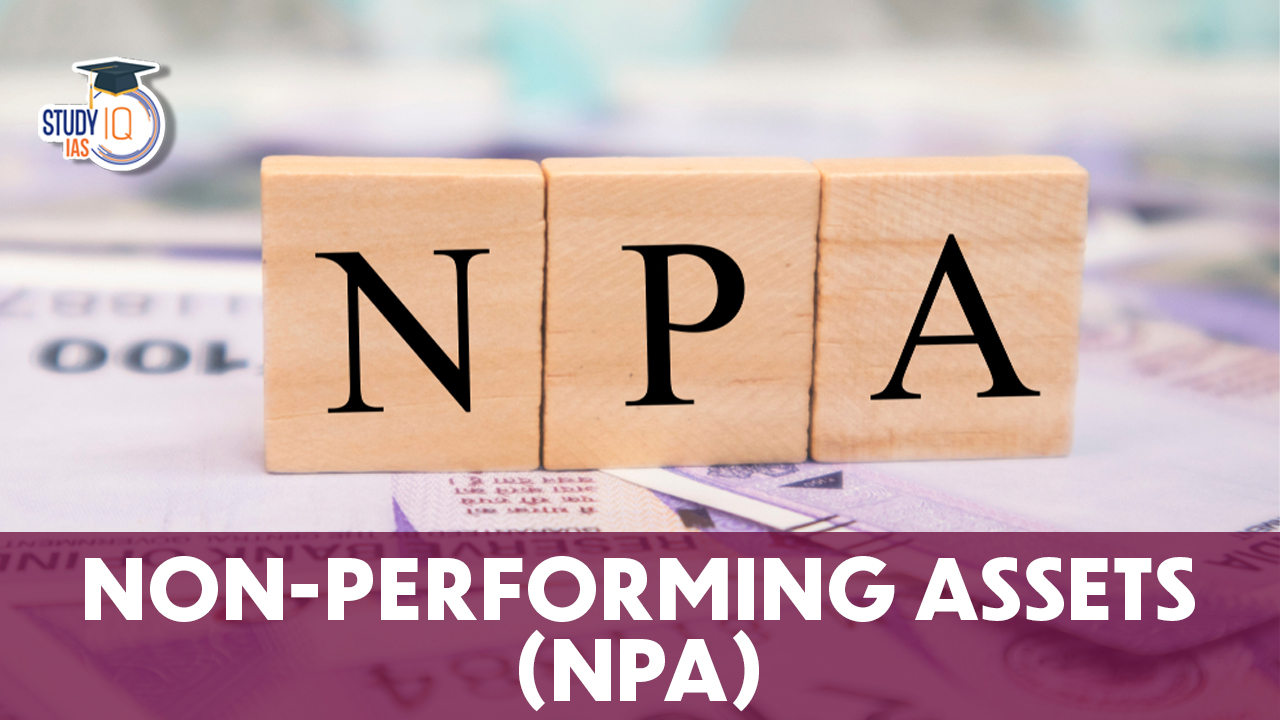Table of Contents
Context: Care Ratings forecasted that GNPAs are expected to be between 2.5-2.7% in FY24 and further improve to 2.1-2.4% by FY25 end.
|
Important Facts |
Historical Trend:
Sector-wise GNPA Ratios (September 2023 compared to March 2020)
|
Non-Performing Assets (NPA)
Non-performing assets (NPAs) are a classification used for loans or advances issued by banks or financial institutions that are no longer generating income. This happens when a borrower fails to make principal or interest payments on the loan for a specific period.
How is a Loan Classified as NPA?
- In general cases, a loan becomes NPA if the borrower misses payments for at least 90 days.
- For agricultural loans, if the borrower doesn’t repay for two cropping seasons.
NPA and Twin Balance Sheet
The existence of NPAs is often indicative of a twin balance sheet crisis. In this scenario, both banks and corporations face significant financial stress. Banks experience difficulties as a result of a high number of NPAs, which erode their profitability and weaken their balance sheets. This situation arises due to the borrowers’ inability to repay their loans, leading to a deterioration in asset quality for the banks.
On the other hand, the corporate sector is overleveraged, meaning that they have taken on excessive debt that they are unable to service. This overleveraging could be due to factors such as economic downturns, poor business performance, or inadequate financial management.
Addressing the twin balance sheet crisis requires coordinated efforts from both banks and corporations. Banks need to take measures to recover or resolve NPAs, including loan restructuring, recovery proceedings, and adequate provisioning. At the same time, corporations should focus on improving their financial health by implementing effective debt management strategies and enhancing their operational performance.
Provisions for Non-Performing Assets
Provision for non-performing assets (NPA) refers to the amount of money that banks and financial institutions set aside from their profits to cover potential losses resulting from NPAs. It is a prudent accounting practice to ensure that financial institutions have adequate funds reserved to absorb the impact of bad loans on their balance sheets.
When a loan is classified as an NPA, it is considered risky and there is a possibility that the borrower may default on the loan entirely or partially. To account for this risk, banks make provisions by setting aside a portion of their profits to create a reserve specifically designated for potential NPA losses. The provision for NPA serves multiple purposes:
Loss Absorption
It acts as a buffer to absorb the potential losses that may arise from defaulting loans. By making provisions, banks protect their capital base and ensure that their financial health is not significantly affected by NPAs.
Prudent Accounting
Provisions for NPAs align with accounting standards and regulatory requirements. Financial institutions are obligated to make adequate provisions based on the classification and ageing of NPAs, as defined by regulatory bodies.
Risk Management
It helps banks manage credit risk effectively by acknowledging the potential losses associated with NPAs. Adequate provisioning assists in maintaining a healthier loan portfolio and mitigating the impact of defaults.
Non-Performing Assets and RBI
The Reserve Bank of India (RBI) has established rules of provision that apply uniformly to all banks dealing with non-performing assets (NPAs). Here are the details of the rules of provision set by the RBI:
Provision for Total Amount
A provision of 10% is applicable to the total amount of NPAs without considering any collateral or government guarantees. This means that banks are required to set aside a provision of 10% of the outstanding amount of NPAs as a safeguard against potential losses.
Additional Provision for Lower Category NPAs
For NPAs that fall into the lower category, an additional provision of 10% is required. This brings the total provision coverage for these NPAs to 20% of the outstanding amount. The lower category typically refers to NPAs that have been classified as substandard or have remained in the substandard category for a certain period.
100% Provision for Suspicious or Unsecured NPAs
NPAs classified as suspicious or unsecured require a provision of 100%. This means that banks must set aside an amount equal to the entire outstanding value of these NPAs as a provision. This category is associated with a high degree of uncertainty or lack of collateral or security for the loans.
Types of Non-Performing Assets
Banks categorise NPAs further based on the overdue period and the likelihood of recovering the loan amount. According to the RBI NPA circular of 2022, there are different types of NPAs. Here’s a breakdown of each type:
Substandard NPA
This type of NPA refers to loans or advances that are overdue for a period of fewer than 12 months or equal. It indicates that the borrower has not made timely payments, but the asset still has some potential for recovery.
Doubtful NPA
The category of doubtful NPA arises when an asset has remained in the substandard category for 12 months or more. It indicates a higher degree of uncertainty regarding the recovery of the loan and a greater risk of loss for the bank or financial institution.
Loss Assets
Loss assets are NPAs where the banks or financial institutions have identified the loans as unrecoverable and recognized them as losses. This recognition usually happens after conducting inspections or assessments in line with RBI guidelines. Loss assets have a minimal chance of recovery, and the financial institution has little or no collateral or security against such loans.
These classifications help banks and financial institutions categorize and assess the quality of their loan portfolios. It allows them to determine the level of provisioning required to account for potential losses from these NPAs. The categorization also plays a crucial role in risk management and decision-making processes related to loan recovery and resolution strategies.
| Gross NPA (GNPA) vs. Net NPA |
|
RBI Guidelines on Non-Performing Assets
The Reserve Bank of India (RBI) has implemented several guidelines to address the issue of non-performing assets (NPAs) and promote their resolution. Here are the details of some key RBI guidelines on NPAs:
Adherence to Strict Timelines
Lenders are required to adhere to strict timelines for the formulation and implementation of resolution plans. This ensures that a well-defined and time-bound process is followed to address NPAs and minimize their impact on the banking system.
Incentivizing Resolution Plans
Lenders are encouraged to provide incentives for borrowers to agree on ongoing resolution plans. This helps create a conducive environment for negotiations and increases the chances of successful resolution and recovery of NPAs.
Strengthening Restructuring Systems
The RBI emphasizes the need to improve the existing restructuring framework, particularly for larger-value loans. This includes implementing robust restructuring mechanisms and ensuring effective monitoring of restructured accounts to prevent the recurrence of NPAs.
Differential Pricing for Non-Cooperative Borrowers
Lenders are permitted to charge higher interest rates on future loans to borrowers who are non-cooperative during the resolution process. This discourages borrowers from defaulting and incentivizes timely repayment and resolution.
Liberal Regulatory Treatment for Asset Sales
The RBI encourages a more liberal regulatory treatment for the sale of distressed assets. This enables lenders to expedite the resolution process by facilitating the sale of NPAs to asset reconstruction companies or other buyers.
Spreading Sales Losses
In cases where a loss is incurred on the sale of an asset, lenders are allowed to spread the losses over a period of at least two years. This provision helps banks manage the financial impact of NPA sales more effectively.
Facilitating Asset Acquisition
Specialized agencies are permitted to provide purchase facilities for the acquisition of stressed companies. This promotes the involvement of specialized entities in the resolution process, facilitating the transfer of stressed assets to more capable hands.
Promoting the Active Role of Private Equity/ Sector-Specific Companies
Steps are taken to facilitate the active participation of private equity firms and sector-specific companies in the distressed asset market. This helps bring in specialized expertise and resources for resolving NPAs in specific sectors.
These guidelines issued by the RBI aim to streamline the resolution process, incentivize timely repayment, and encourage effective asset management to address the issue of NPAs in the Indian banking system.
Non-Performing Assets UPSC
The topic of non-performing assets (NPAs) holds immense importance for the UPSC examination as it aligns with the UPSC Syllabus, requiring candidates to have a comprehensive understanding of the Indian economy, banking, and financial institutions. Being aware of NPAs and their implications is crucial for tackling questions related to the Economics and Indian Economy sections of the UPSC exam. Moreover, candidates can enhance their preparation through resources such as UPSC Online Coaching and UPSC Mock Test, which provide a structured learning environment and practice opportunities to analyze case studies, regulatory frameworks, and policy measures pertaining to NPAs in the Indian banking sector.


 Top 10 Economies in the World 2025, Chec...
Top 10 Economies in the World 2025, Chec...
 Minors Bank Account above 10 Years: Chan...
Minors Bank Account above 10 Years: Chan...
 Creative Economy in India, Current Situa...
Creative Economy in India, Current Situa...





















